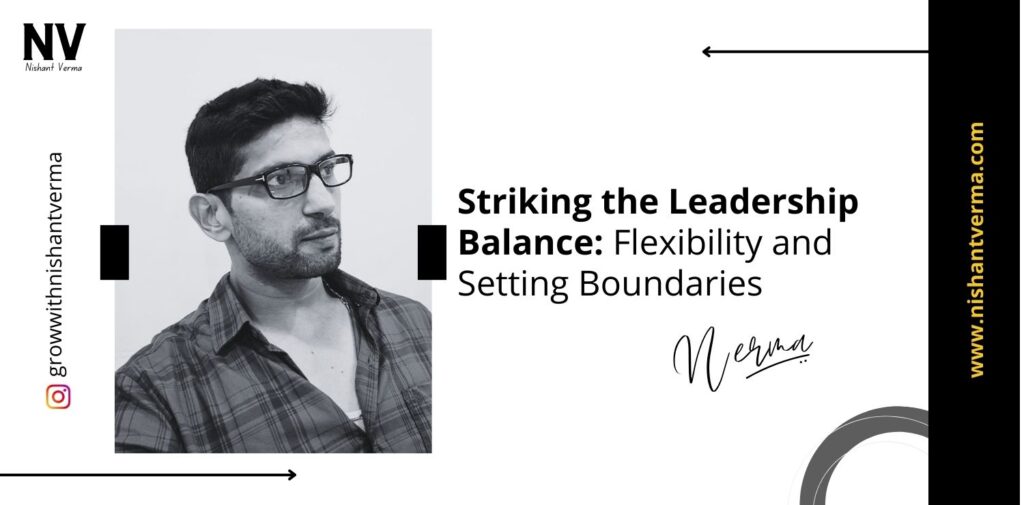Striking the Leadership Balance is like guiding a ship through the sea of responsibilities. This article will explore the simple and essential art of setting boundaries while balancing flexibility. Join us to understand how leaders can create a harmonious workplace where structure and adaptability coexist.
I. Introduction: The Art of Striking the Leadership Balance
Imagine leadership as a tightrope walk between structure and flexibility. Let’s simplify why balancing boundaries is crucial:
- Efficiency: Setting boundaries ensures tasks are completed efficiently and on time.
- Adaptability: Flexibility allows for innovation and adaptation to changing circumstances.
- Employee Well-being: A balanced approach fosters a positive work environment, supporting the employee well-being of team members.
II. The Leader’s Role in Boundary Setting: A Compass for the Team
Leaders are like compasses guiding their teams through the delicate dance of boundaries and flexibility. Here’s how leaders contribute:
- Clear Communication: Leaders communicate expectations and boundaries clearly to avoid confusion.
- Empathy: Leaders understand and Striking the Leadership Balance individual needs with the team’s goals.
- Adaptability: Leaders remain flexible, adjusting boundaries when necessary for the team’s well-being.

III. Defining Boundaries in Leadership: Breaking it Down
Boundaries are not rigid walls; let’s break them down into simple components:
- Time Boundaries: Setting realistic deadlines and respecting work hours.
- Task Boundaries: Defining roles and responsibilities to avoid overlap or confusion.
- Communication Boundaries: Establishing guidelines for effective and respectful communication.
IV. The Balancing Act: Flexibility and Adaptability
Balancing flexibility is like dancing to the rhythm of change. Simplifying the importance of flexibility:
- Innovation: Flexibility allows for creative problem-solving and innovation.
- Employee Satisfaction: Flexibility contributes to a positive work culture, enhancing job satisfaction.
- Team Collaboration: An adaptable environment fosters collaboration and teamwork.
V. Case Studies: Real-Life Examples of Effective Boundary Setting
Let’s draw inspiration from real-life leaders who have effectively balanced boundaries and flexibility:
- Leader A: Communicated task boundaries, allowing team members to focus on their strengths and collaborate effectively.
- Team B: Established time boundaries to promote a healthy work-life Striking the Leadership Balance, increasing productivity and employee satisfaction.
- Organization C: Fostered open communication boundaries, encouraging team members to share ideas and concerns, leading to a culture of transparency.
VI. Challenges in Balancing Boundaries: Facing Realities
Challenges are like puzzles in the boundary-setting journey. Let’s acknowledge and address a few common ones:
- Overlapping Responsibilities: Team members might struggle with unclear task boundaries, leading to inefficiencies.
- Burnout: Insufficient time boundaries may contribute to burnout and decreased well-being.
- Resistance to Change: Introducing new boundaries can face resistance to change; effective communication is important.

VII. Strategies for Leaders to Balance Boundaries Effectively: A Practical Guide
Leaders can Striking the Leadership Balance boundaries effectively with practical strategies, such as:
- Transparent Communication: Communicate expectations and changes in boundaries.
- Flexible Policies: Implement policies that allow for adaptability while maintaining essential structure.
- Regular Check-Ins: Periodically assess the effectiveness of existing boundaries and make adjustments as needed.
VIII. Setting Boundaries in Time Management: A Key to Productivity
Time management is like a well-organized puzzle. Leaders can set effective boundaries by:
- Prioritizing Tasks: Helping team members identify and focus on high-priority tasks.
- Avoiding Micromanagement: Allowing team members the autonomy to manage their time effectively.
- Providing Resources: Ensuring team members have the necessary resources to meet deadlines.
IX. The Role of Leadership Styles in Boundary Setting: A Simplified Approach
Leadership styles impact boundary setting. Let’s simplify a few styles and their effects:
- Authoritative Leadership: Clearly defines boundaries and expectations, providing structure.
- Transformational Leadership: Inspires adaptability and innovation while maintaining overall structure.
- Democratic Leadership: Involves team members in the boundary-setting process, fostering collaboration.
X. Building a Culture of Accountability: Boundaries in Action
Accountability is like the glue that holds boundaries together. Leaders can foster culture of accountability by:
- Clear Expectations: Communicating expectations and holding team members accountable.
- Feedback Mechanisms: Providing constructive feedback to reinforce positive behaviors.
- Recognition: Acknowledging and celebrating achievements within established boundaries.
XI. Measuring the Impact of Balanced Boundaries: Metrics Simplified
Measuring the impact is like checking the pulse of a healthy workplace. Simplified metrics for evaluation include:
- Employee Surveys: Assessing satisfaction with the Striking the Leadership Balance between flexibility and boundaries.
- Productivity Metrics: Evaluating team and individual productivity as an indicator of effective time management.
- Employee Turnover Rates: Monitoring turnover rates to gauge the team’s well-being
XII. The Ethical Dimension of Boundary Setting: Leading with Fairness
Ethics is the compass guiding boundary setting. Leaders can lead ethically by:
- Fairness: Ensuring boundaries are applied consistently and fairly across the team.
- Respect: Respect team members’ individual needs and well-being when setting boundaries.
- Openness: Maintaining open communication about changes in boundaries and expectations.
XIII. Navigating Boundaries in Remote Work Environments: A New Challenge
Remote work adds a layer of complexity to boundary setting. Leaders can navigate this challenge by:
- Clear Remote Policies: Establishing clear policies for remote work expectations and boundaries.
- Technology Tools: Providing tools that facilitate communication and collaboration in virtual environments.
- Regular Check-Ins: Regular check-ins to address concerns and ensure team members feel supported.

XIV. Creating a Supportive Environment: The Heart of Striking the Leadership Balance Leadership
A supportive environment is the foundation of effective boundary setting. Leaders can create this by:
- Open Door Policy: Encouraging open communication where team members feel comfortable discussing concerns.
- Mental Health Resources: Providing access to resources that support the team’s mental well-being.
- Flexible Benefits: Offering benefits that accommodate the diverse needs of team members.
Conclusion: Leaders as Choreographers of Striking the Leadership Balance
Leaders are the choreographers in the grand performance of leadership, orchestrating the delicate dance between boundaries and flexibility. As choreographers, leaders can create workplaces where structure and adaptability coexist harmoniously, team members thrive within well-defined boundaries, and all feel the Striking the Leadership Balance rhythm. Let’s build environments where leaders lead with clarity, empathy, and a commitment to the well-being of their teams, ensuring that the dance of productivity and innovation continues in perfect harmony.




